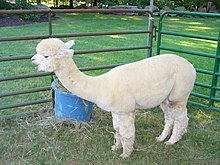Alpacas
| Alpaca | |
|---|---|
 |
|
| Alpaca | |
|
Domesticated
|
|
| Scientific classification | |
| Kingdom: | Animalia |
| Phylum: | Chordata |
| Class: | Mammalia |
| Order: | Artiodactyla |
| Family: | Camelidae |
| Genus: | Vicugna |
| Species: | V. pacos |
| Binomial name | |
|
Vicugna pacos (Linnaeus, 1758) |
|
 |
|
| Alpaca range | |
An alpaca (Vicugna pacos) is a domesticated species of South American camelid. It resembles a small llama in appearance.
There are two breeds of alpaca; the and the Huacaya alpaca.
Alpacas are kept in herds that graze on the level heights of the Andes of southern Peru, northern Bolivia, Ecuador, and northern Chile at an altitude of 3,500 m (11,500 ft) to 5,000 m (16,000 ft) above sea level, throughout the year. Alpacas are considerably smaller than llamas, and unlike llamas, they were not bred to be beasts of burden, but were bred specifically for their fiber. Alpaca fiber is used for making knitted and woven items, similar to wool. These items include blankets, sweaters, hats, gloves, scarves, a wide variety of textiles and ponchos in South America, and sweaters, socks, coats and bedding in other parts of the world. The fiber comes in more than 52 natural colors as classified in Peru, 12 as classified in Australia and 16 as classified in the United States.
In the textile industry, "alpaca" primarily refers to the hair of Peruvian alpacas, but more broadly it refers to a style of fabric originally made from alpaca hair, but now often made from similar fibers, such as mohair, Icelandic sheep wool, or even high-quality English wool. In trade, distinctions are made between alpacas and the several styles of mohair and luster.
An adult alpaca generally is between 81–99 centimetres (32–39 in) in height at the shoulders (withers). They usually weigh 48–84 kilograms (106–185 lb).
Alpacas have been domesticated for thousands of years. The Moche people of northern Peru often used alpaca images in their art. There are no known wild alpacas, and its closest living relative, the vicuña (also native to South America), are believed to be the wild ancestor of the alpaca. The alpaca is larger than the vicuña, but smaller than the other camelid species.
...
Wikipedia
